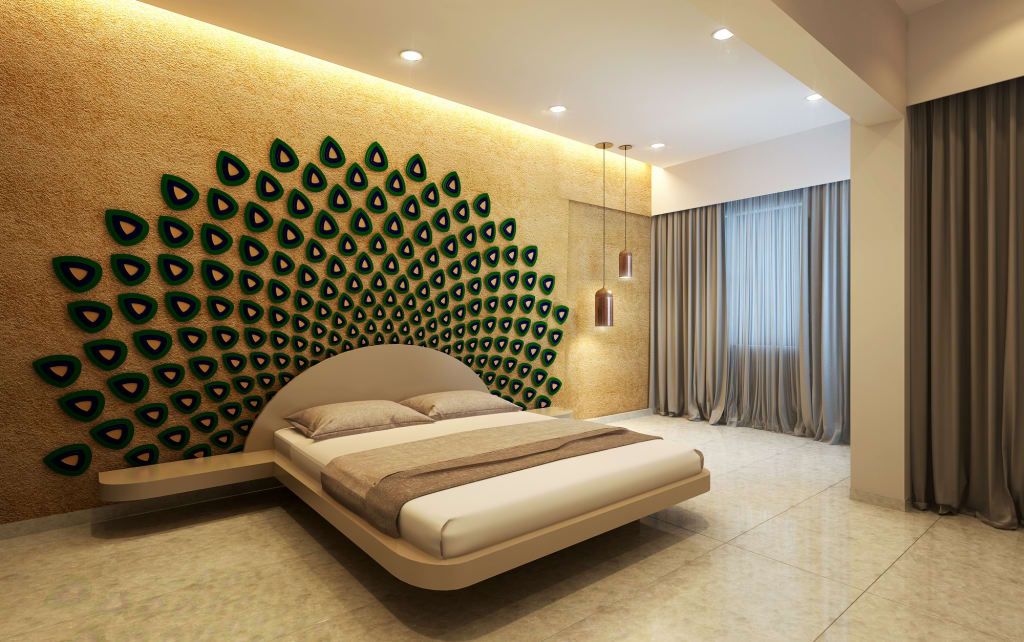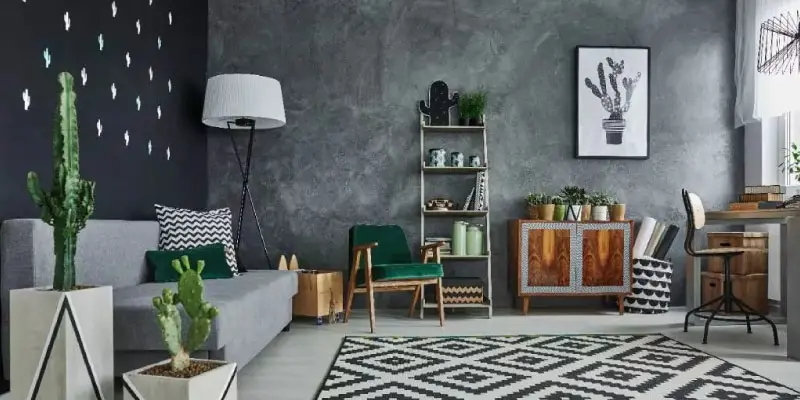
Introduction
A number of cutting-edge trends have emerged in India’s interior design industry in recent years, signaling a significant transformation in the field. Among these, the use of textural elements in interior spaces is one of the most common. Textural components give designs depth, interest, and a tactile quality, resulting in environments that are rich in sensory experiences in addition to being aesthetically pleasing. This article examines the history, essential elements, and industry impact of the expanding trend of textural elements in Indian interior design.
The Rise of Textural Elements
Although textural components have always been important in interior design, their popularity has recently increased as a result of both technological advancements and aesthetic preferences. Texture has become a tool for fusing modernity and traditional aesthetics in India, a nation renowned for its rich cultural legacy and varied design traditions. Growing interest in organic, handcrafted materials and the revival of artisanal crafts have both contributed to this trend.
Cultural Influences
With its plethora of traditional crafts and techniques, India’s vast cultural tapestry offers an ideal environment for incorporating textural elements into modern interior design. Indian design has long celebrated texture, from elaborately carved woodwork to intricate handwoven textiles. These days, creative modern designers are giving these classic components new meanings, resulting in environments that embrace modernity while paying tribute to history.
Technological Advancements
Advancements in technology have also played a crucial role in the rise of textural elements. The availability of new materials and manufacturing processes allows designers to experiment with textures in ways that were previously impossible. Techniques such as 3D printing, laser cutting, and digital weaving enable the creation of intricate patterns and surfaces, adding a new dimension to interior design.
Key Components of Textural Design
Textural design encompasses a wide range of materials and techniques, each contributing to the overall sensory experience of a space. The following are some key components that have become increasingly popular in Indian interior design:
Natural Materials
The use of natural materials is central to textural design. Materials such as stone, wood, and clay bring an organic, tactile quality to interiors. For example, exposed brick walls, stone cladding, and wooden beams add rustic charm and a sense of warmth. These materials are not only aesthetically pleasing but also sustainable, aligning with the growing emphasis on eco-friendly design.
Textiles and Fabrics
Textiles and fabrics are perhaps the most versatile elements in textural design. Handwoven rugs, embroidered cushions, and silk drapes introduce a variety of textures and patterns. Indian textiles, with their rich history and intricate designs, are particularly well-suited to this trend. Designers are increasingly incorporating traditional textiles like khadi, ikat, and block-printed fabrics into contemporary interiors, creating a fusion of old and new.
Wall Treatments
Walls offer a vast canvas for exploring texture. Techniques such as stucco, Venetian plaster, and textured paint can transform flat surfaces into dynamic focal points. Wallpaper with raised patterns or metallic finishes adds depth and interest. In India, traditional techniques like fresco painting and lime plaster are being revived and adapted for modern interiors.

Furniture and Accessories
Furniture and accessories play a crucial role in enhancing the textural quality of a space. Upholstered furniture with tufted or quilted surfaces, wicker chairs, and carved wooden pieces add layers of texture. Accessories such as ceramic vases, woven baskets, and metal sculptures further enrich the tactile experience.
The Impact on Indian Interior Design
The incorporation of textural elements has had a profound impact on the interior design industry in India. It has influenced various aspects of design practice, from residential interiors to commercial spaces, and has led to a renewed appreciation for craftsmanship and materiality.
Residential Interiors
In residential interiors, textural elements create warm, inviting spaces that reflect the personality and lifestyle of the occupants. Homes adorned with textured walls, artisanal textiles, and handcrafted furniture exude a sense of comfort and individuality. The use of texture also allows for greater flexibility in design, enabling homeowners to experiment with different styles and themes.
Commercial Spaces
In commercial spaces, texture is used to enhance the overall ambiance and user experience. Hotels, restaurants, and retail stores are increasingly incorporating textural elements to create distinctive, memorable environments. For example, a restaurant with exposed brick walls, wooden furniture, and woven light fixtures can evoke a rustic, cozy atmosphere that enhances the dining experience.
Craftsmanship and Artisanal Revival
The emphasis on texture has also led to a resurgence of interest in traditional crafts and artisanal techniques. Designers are collaborating with local artisans to create bespoke pieces that celebrate India’s rich craft heritage. This not only supports local economies but also ensures the preservation of traditional skills and knowledge.
Sustainable Design
The increasing desire for eco-friendly interiors is reflected in the use of natural and sustainable materials in textural design. Sustainable, locally sourced, and low-impact materials are becoming more and more important to designers. Laws and consumer awareness are driving a larger trend in the interior design industry toward sustainability, which is reflected in this pattern.
Case Studies
Case Study 1: A Modern Indian Home
A modern Bangalore house exemplifies the harmonious coexistence of textural elements and contemporary design. A handwoven rug and a wooden coffee table balance out the room’s striking accent wall made of natural stone. Block-printed cushions and silk draperies are examples of traditional Indian textiles that are used to add layers of color and texture. The overall result is a tasteful fusion of traditional craftsmanship and contemporary aesthetics.
Case Study 2: A Boutique Hotel in Jaipur
An example of a boutique hotel in Jaipur that uses texture to create a distinctive and engaging guest experience is this one. Textural elements abound in the hotel’s interior design, ranging from vibrant textile wall hangings to intricately carved wooden furniture. The use of local materials and time-honored techniques like fresco painting and marble inlay, which also create an opulent and tactile atmosphere, honor the rich cultural legacy of the area.
Case Study 3: A Concept Store in Mumbai
A concept store in Mumbai illustrates how textural design can enhance retail spaces. The store features exposed brick walls, reclaimed wood shelving, and metal accents, creating an industrial-chic aesthetic. Handcrafted pottery, woven baskets, and textile displays add warmth and texture, inviting customers to engage with the products on a sensory level. The result is a retail environment that feels both modern and artisanal.
Conclusion
The incorporation of textural elements in Indian interior design signifies a noteworthy transition towards more tactile and sensory-dense spaces. This movement could revolutionize the way spaces are created and used because it represents a wider appreciation for sustainability, materiality, and artistry. The future of interior design in India looks to be both exciting and richly traditional, as Indian designers continue to experiment and innovate with textures.
Incorporating textural elements into interior design not only improves visual appeal but also results in environments that have a more profound, visceral resonance. Designers and homeowners alike can create environments that are not only aesthetically pleasing but also lasting and meaningful by adopting this trend.